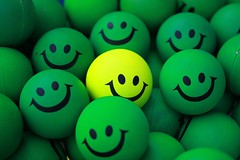
My generation were among the first children to learn programming. Thanks to the BBC Microcomputer (in my part of the world), kids were provided with a computer and a manual that taught computer programming in both BASIC and Logo. The local library had a complete set of Usborne books that covered everything from arcade games, to fantasy adventures (the old-school text only type, that is), to assembly language programming and sorting algorithms. And these were for children.
So what was it about programming on the BBC (or ZX Spectrum or Commodore 64) that drew kids in? For me it was all about graphics. Drawing circles could only be done dot by dot and led easily to drawing ellipses, and then to
hyperboloids of revolution (think cooling towers) whose top you could twist. I read Chaos by James Gleick, couldn't believe the simplicity of generating the Mandelbrot fractal, and lifted my jaw off the floor the first time my BBC drew the little Mandelbeetle (I'm not the only one - see also
PMR). I did some astronomy at school and plotted the night sky for different months of the year. And so on.
Since then we've seen the rise of the PC and Windows, which in fairness had QBasic for quite some time (I am a
Nibbles master). However, as David Brin pointed out ("
Why Johnny can't code", 2006) today there's no easy way for kids to get hooked on programming. Even my favourite language, Python, is lacking here. Out of the box the only usable graphics library for kids is the turtle module, an implementation of LOGO:
C:\Documents and Settings\oboyle> python
Python 2.6.1 (r261:67517, Dec 4 2008, ...
Type "help", "copyright", "credits" ...
>>> from turtle import *
>>> for i in range(10):
... for j in range(5):
... forward(100)
... left(360/5)
... left(360/10)
...
>>>

It seems to work quite well, although the
documentation is aimed at computer science majors rather than teachers (never mind kids). Also, the demo files are only available in the source distribution (you can get them from SVN
here).
While Logo might be quite good for introducing the basics of programming languages, its graphics capabilities are limited.
pygame is really the way to go. This is one of the big third-party Python extensions that incorporates support for sound, graphics and input devices. As the name implies it has everything necessary to write a decent computer game (see for example, the list of pygame
arcade games). The downside is that this library makes no effort to cater for kids.
Enter a recent publication from Manning, "
Hello World! - Computer programming for kids and other beginners" by Warren and Carter Sande. Written with 12 year old kids in mind, the preface makes it clear that the authors (one a 12-year old kid himself) know their target audience well:
"For kids especially, one of the most fun parts of using a computer is playing games, with graphics and sound. We’re going to learn how to make our own games and do lots of things with graphics and sound as we go along. Here are pictures of some of the programs we’ll be making:"

(
Figure published with permission from Manning Publications)
Lunar lander! Slalom racing! The Sandes have reinvented the Usborne books for the YouTellyTub generation, and then some. Assuming no previous programming knowledge (a reasonable assumption when you're 12), the book teaches Python programming with the goal of writing computer games. The initial chapters cover the basics from variables, through maths, "if" statements and loops. But there's also already the fun stuff like getting input and simple graphical dialogs, and in case attention is waning Chapter 10 (of 24) has the complete listing for a Skiing game. As the book says:"One of the great traditions of learning to program is typing in code you don’t understand. Really!"
After introducing lists, functions, objects and modules, pygame enters the picture in Chapter 16 which covers drawing, images and animation. The following chapters cover sprites and collision detection, events and sound. The final chapters return to useful Python modules such as handling strings, file input and output, and using random numbers. All of the code examples are available for download from the
book's website, along with a simple installer that contains all of the examples and modules required, along with Python itself.
As you might have guessed, I think this is a great book that fills a real niche - I don't know of any other programming book on the market that targets kids. What's amazing is that it has set its sights so high, and yet manages to meet its goals. I think it would be great to see this book promoted as a way of teaching programming in primary schools. In the meanwhile if you know any 12+ kids interested in computers, give them an opportunity to develop a fascinating hobby and get them this book.
 As many readers of this blog will be aware, a chiral SMILES is not a lopsided grin. Instead it is a way of describing the relative spatial arrangement of groups around a chiral centre using SMILES notation.
As many readers of this blog will be aware, a chiral SMILES is not a lopsided grin. Instead it is a way of describing the relative spatial arrangement of groups around a chiral centre using SMILES notation.



